Detailed Network Design and Analysis for Ministry of Education
VerifiedAdded on 2022/11/01
|9
|1349
|336
Report
AI Summary
This document presents a network design proposal for the Ministry of Education, catering to five departments with specific needs for resource sharing and communication. The proposal outlines hardware and software requirements, functional and non-functional requirements, and evaluates three different network designs (A, B, and C) based on bus and star topologies. Each design's advantages and disadvantages are discussed, with a performance analysis focusing on latency, bandwidth, throughput, jitter, and error rate. Design B is identified as more efficient due to its higher bandwidth and lower latency. The report concludes with innovative ideas for improvement, such as a star-ring topology and IPv6 addressing, to enhance network performance and scalability. Desklib offers a wealth of similar solved assignments and resources for students.
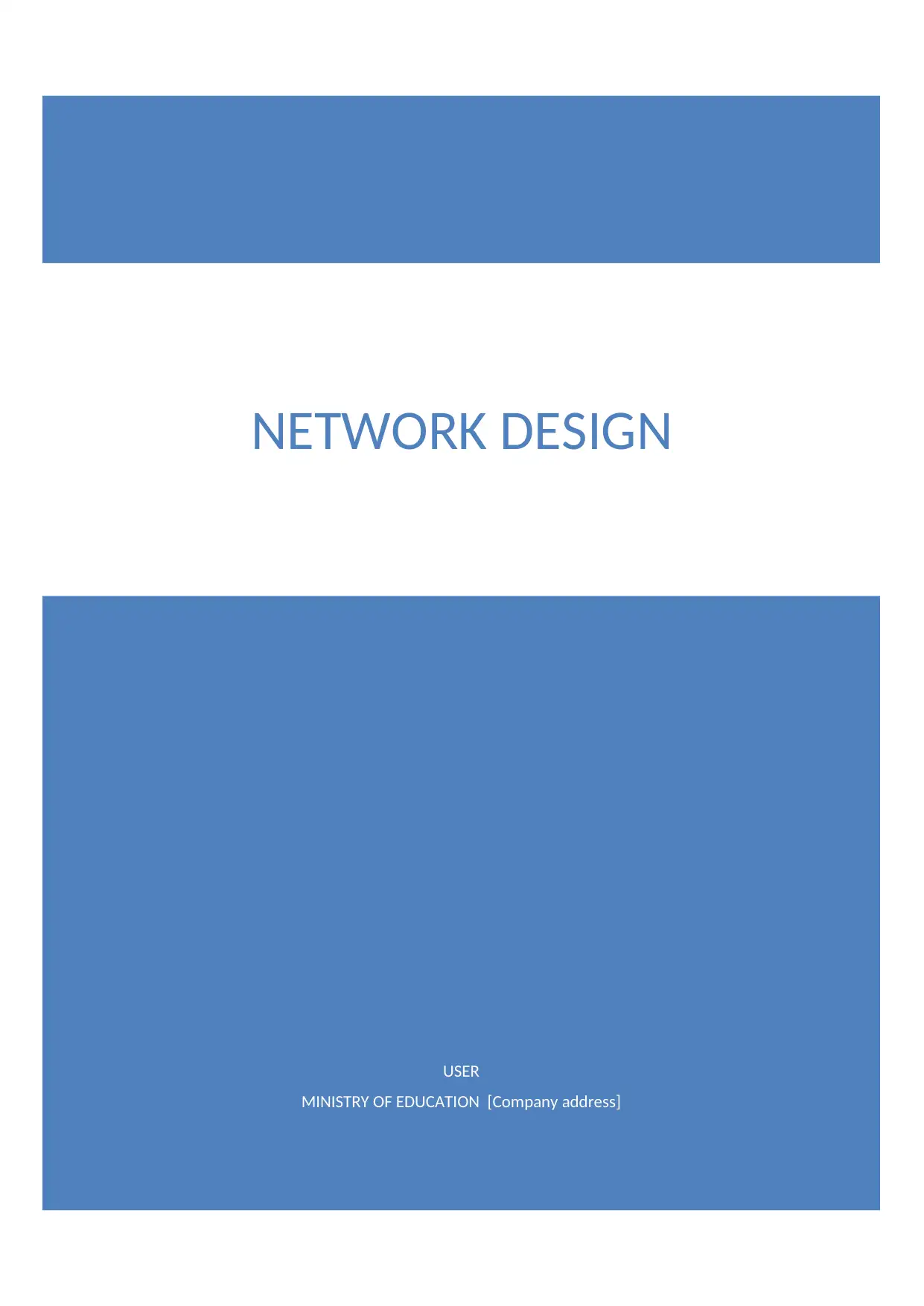
USER
MINISTRY OF EDUCATION [Company address]
NETWORK DESIGN
MINISTRY OF EDUCATION [Company address]
NETWORK DESIGN
Paraphrase This Document
Need a fresh take? Get an instant paraphrase of this document with our AI Paraphraser
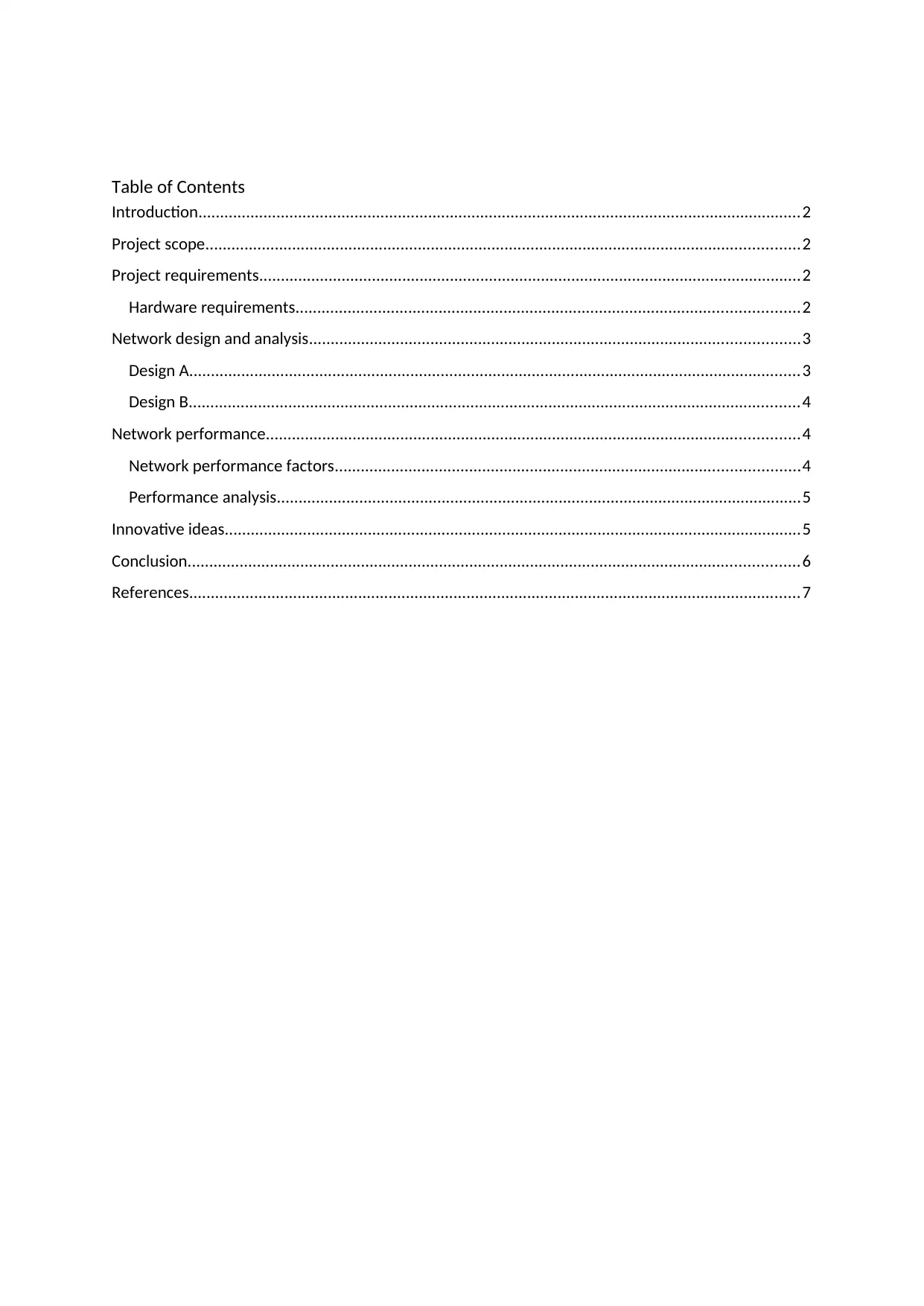
Table of Contents
Introduction...........................................................................................................................................2
Project scope.........................................................................................................................................2
Project requirements.............................................................................................................................2
Hardware requirements....................................................................................................................2
Network design and analysis.................................................................................................................3
Design A.............................................................................................................................................3
Design B.............................................................................................................................................4
Network performance...........................................................................................................................4
Network performance factors...........................................................................................................4
Performance analysis.........................................................................................................................5
Innovative ideas.....................................................................................................................................5
Conclusion.............................................................................................................................................6
References.............................................................................................................................................7
Introduction...........................................................................................................................................2
Project scope.........................................................................................................................................2
Project requirements.............................................................................................................................2
Hardware requirements....................................................................................................................2
Network design and analysis.................................................................................................................3
Design A.............................................................................................................................................3
Design B.............................................................................................................................................4
Network performance...........................................................................................................................4
Network performance factors...........................................................................................................4
Performance analysis.........................................................................................................................5
Innovative ideas.....................................................................................................................................5
Conclusion.............................................................................................................................................6
References.............................................................................................................................................7
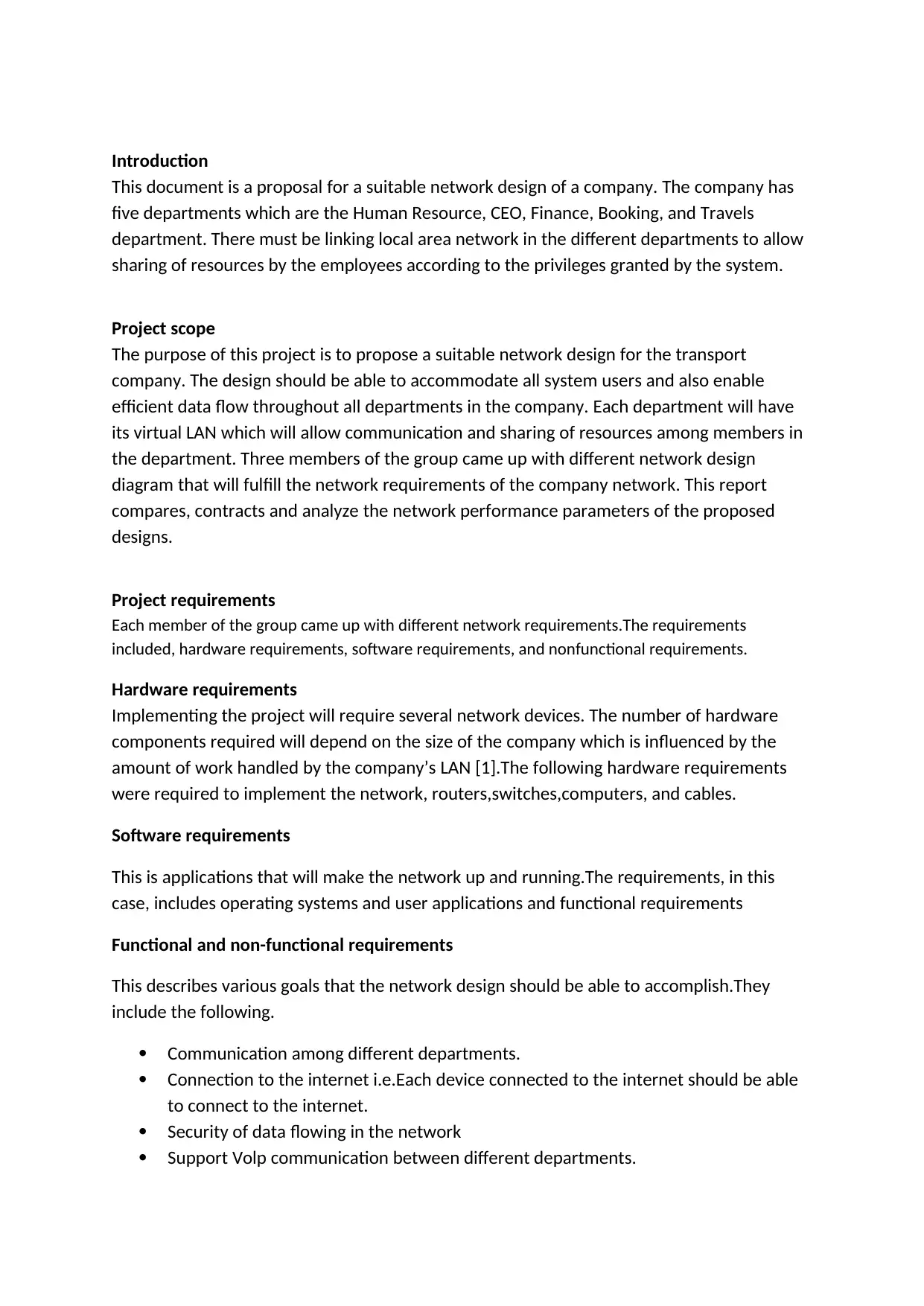
Introduction
This document is a proposal for a suitable network design of a company. The company has
five departments which are the Human Resource, CEO, Finance, Booking, and Travels
department. There must be linking local area network in the different departments to allow
sharing of resources by the employees according to the privileges granted by the system.
Project scope
The purpose of this project is to propose a suitable network design for the transport
company. The design should be able to accommodate all system users and also enable
efficient data flow throughout all departments in the company. Each department will have
its virtual LAN which will allow communication and sharing of resources among members in
the department. Three members of the group came up with different network design
diagram that will fulfill the network requirements of the company network. This report
compares, contracts and analyze the network performance parameters of the proposed
designs.
Project requirements
Each member of the group came up with different network requirements.The requirements
included, hardware requirements, software requirements, and nonfunctional requirements.
Hardware requirements
Implementing the project will require several network devices. The number of hardware
components required will depend on the size of the company which is influenced by the
amount of work handled by the company’s LAN [1].The following hardware requirements
were required to implement the network, routers,switches,computers, and cables.
Software requirements
This is applications that will make the network up and running.The requirements, in this
case, includes operating systems and user applications and functional requirements
Functional and non-functional requirements
This describes various goals that the network design should be able to accomplish.They
include the following.
Communication among different departments.
Connection to the internet i.e.Each device connected to the internet should be able
to connect to the internet.
Security of data flowing in the network
Support Volp communication between different departments.
This document is a proposal for a suitable network design of a company. The company has
five departments which are the Human Resource, CEO, Finance, Booking, and Travels
department. There must be linking local area network in the different departments to allow
sharing of resources by the employees according to the privileges granted by the system.
Project scope
The purpose of this project is to propose a suitable network design for the transport
company. The design should be able to accommodate all system users and also enable
efficient data flow throughout all departments in the company. Each department will have
its virtual LAN which will allow communication and sharing of resources among members in
the department. Three members of the group came up with different network design
diagram that will fulfill the network requirements of the company network. This report
compares, contracts and analyze the network performance parameters of the proposed
designs.
Project requirements
Each member of the group came up with different network requirements.The requirements
included, hardware requirements, software requirements, and nonfunctional requirements.
Hardware requirements
Implementing the project will require several network devices. The number of hardware
components required will depend on the size of the company which is influenced by the
amount of work handled by the company’s LAN [1].The following hardware requirements
were required to implement the network, routers,switches,computers, and cables.
Software requirements
This is applications that will make the network up and running.The requirements, in this
case, includes operating systems and user applications and functional requirements
Functional and non-functional requirements
This describes various goals that the network design should be able to accomplish.They
include the following.
Communication among different departments.
Connection to the internet i.e.Each device connected to the internet should be able
to connect to the internet.
Security of data flowing in the network
Support Volp communication between different departments.
⊘ This is a preview!⊘
Do you want full access?
Subscribe today to unlock all pages.

Trusted by 1+ million students worldwide
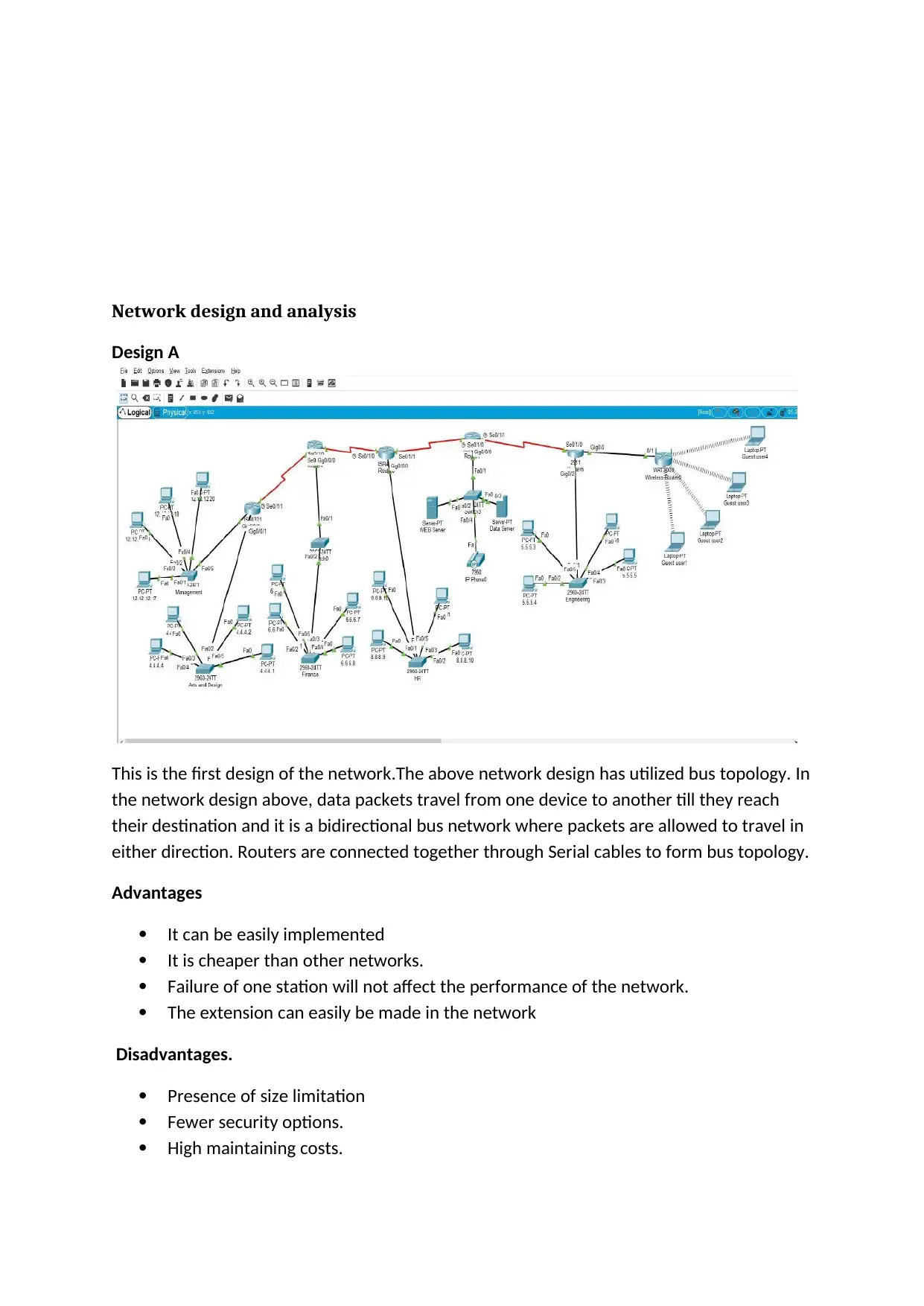
Network design and analysis
Design A
This is the first design of the network.The above network design has utilized bus topology. In
the network design above, data packets travel from one device to another till they reach
their destination and it is a bidirectional bus network where packets are allowed to travel in
either direction. Routers are connected together through Serial cables to form bus topology.
Advantages
It can be easily implemented
It is cheaper than other networks.
Failure of one station will not affect the performance of the network.
The extension can easily be made in the network
Disadvantages.
Presence of size limitation
Fewer security options.
High maintaining costs.
Design A
This is the first design of the network.The above network design has utilized bus topology. In
the network design above, data packets travel from one device to another till they reach
their destination and it is a bidirectional bus network where packets are allowed to travel in
either direction. Routers are connected together through Serial cables to form bus topology.
Advantages
It can be easily implemented
It is cheaper than other networks.
Failure of one station will not affect the performance of the network.
The extension can easily be made in the network
Disadvantages.
Presence of size limitation
Fewer security options.
High maintaining costs.
Paraphrase This Document
Need a fresh take? Get an instant paraphrase of this document with our AI Paraphraser
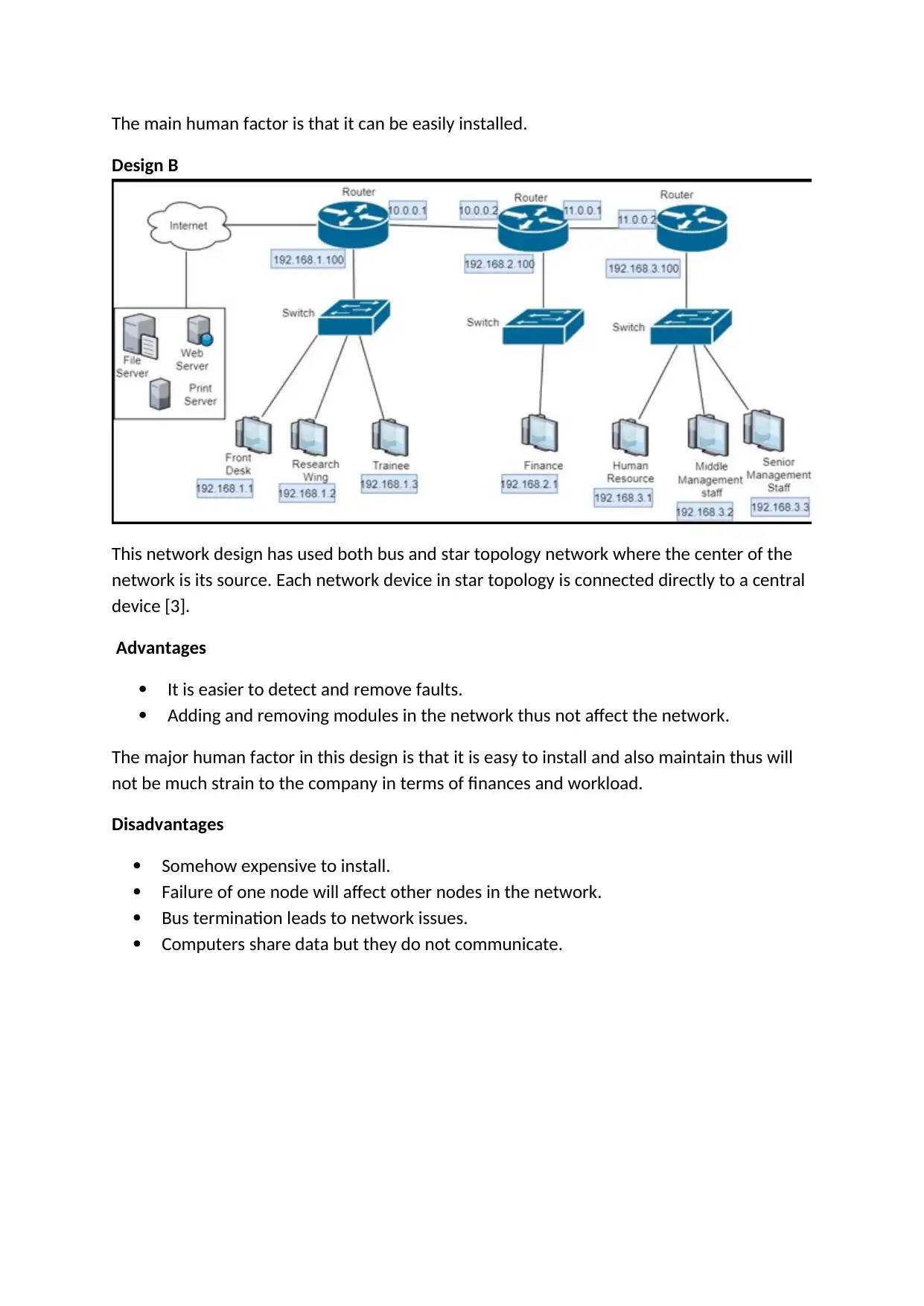
The main human factor is that it can be easily installed.
Design B
This network design has used both bus and star topology network where the center of the
network is its source. Each network device in star topology is connected directly to a central
device [3].
Advantages
It is easier to detect and remove faults.
Adding and removing modules in the network thus not affect the network.
The major human factor in this design is that it is easy to install and also maintain thus will
not be much strain to the company in terms of finances and workload.
Disadvantages
Somehow expensive to install.
Failure of one node will affect other nodes in the network.
Bus termination leads to network issues.
Computers share data but they do not communicate.
Design B
This network design has used both bus and star topology network where the center of the
network is its source. Each network device in star topology is connected directly to a central
device [3].
Advantages
It is easier to detect and remove faults.
Adding and removing modules in the network thus not affect the network.
The major human factor in this design is that it is easy to install and also maintain thus will
not be much strain to the company in terms of finances and workload.
Disadvantages
Somehow expensive to install.
Failure of one node will affect other nodes in the network.
Bus termination leads to network issues.
Computers share data but they do not communicate.
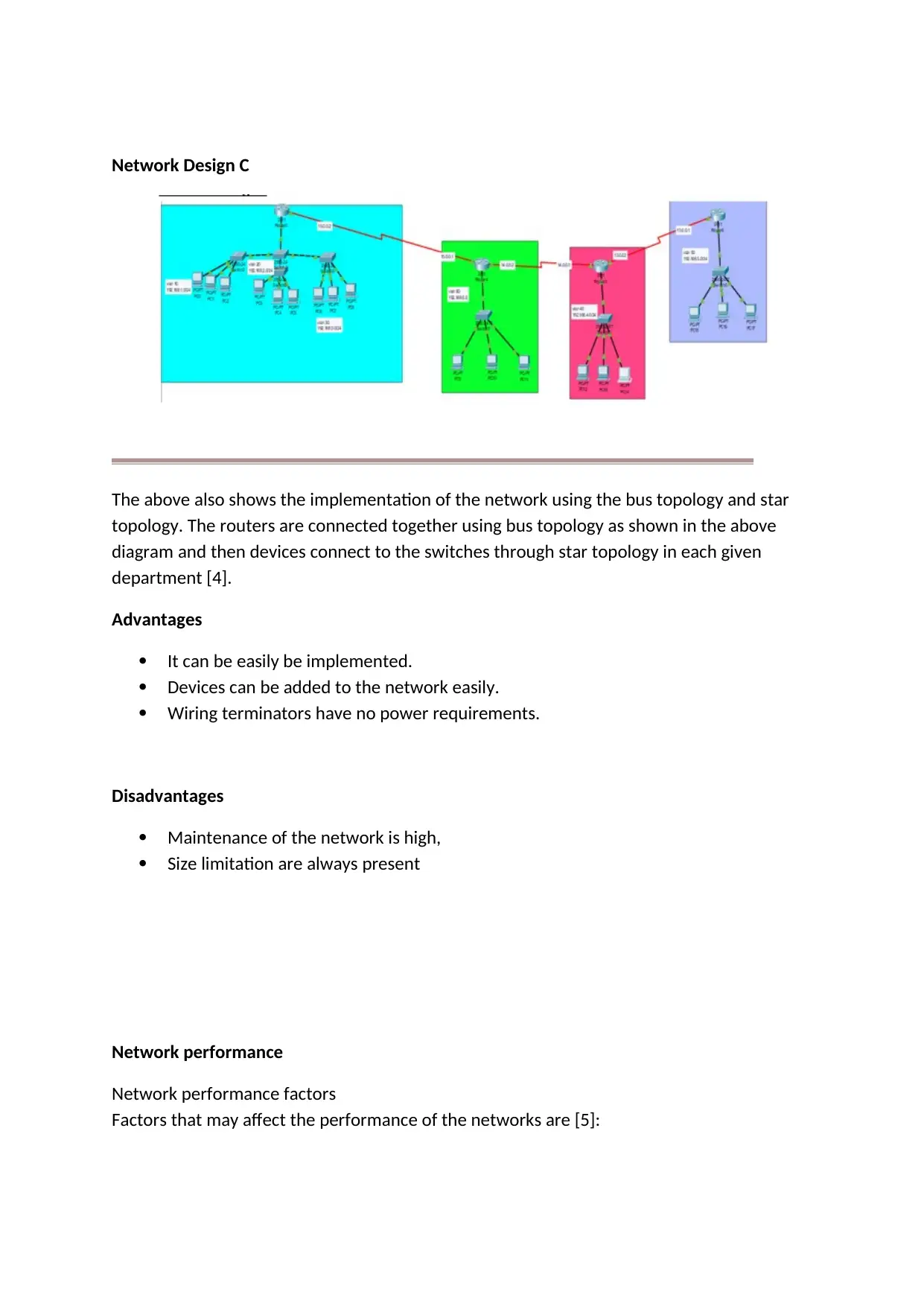
Network Design C
The above also shows the implementation of the network using the bus topology and star
topology. The routers are connected together using bus topology as shown in the above
diagram and then devices connect to the switches through star topology in each given
department [4].
Advantages
It can be easily be implemented.
Devices can be added to the network easily.
Wiring terminators have no power requirements.
Disadvantages
Maintenance of the network is high,
Size limitation are always present
Network performance
Network performance factors
Factors that may affect the performance of the networks are [5]:
The above also shows the implementation of the network using the bus topology and star
topology. The routers are connected together using bus topology as shown in the above
diagram and then devices connect to the switches through star topology in each given
department [4].
Advantages
It can be easily be implemented.
Devices can be added to the network easily.
Wiring terminators have no power requirements.
Disadvantages
Maintenance of the network is high,
Size limitation are always present
Network performance
Network performance factors
Factors that may affect the performance of the networks are [5]:
⊘ This is a preview!⊘
Do you want full access?
Subscribe today to unlock all pages.

Trusted by 1+ million students worldwide
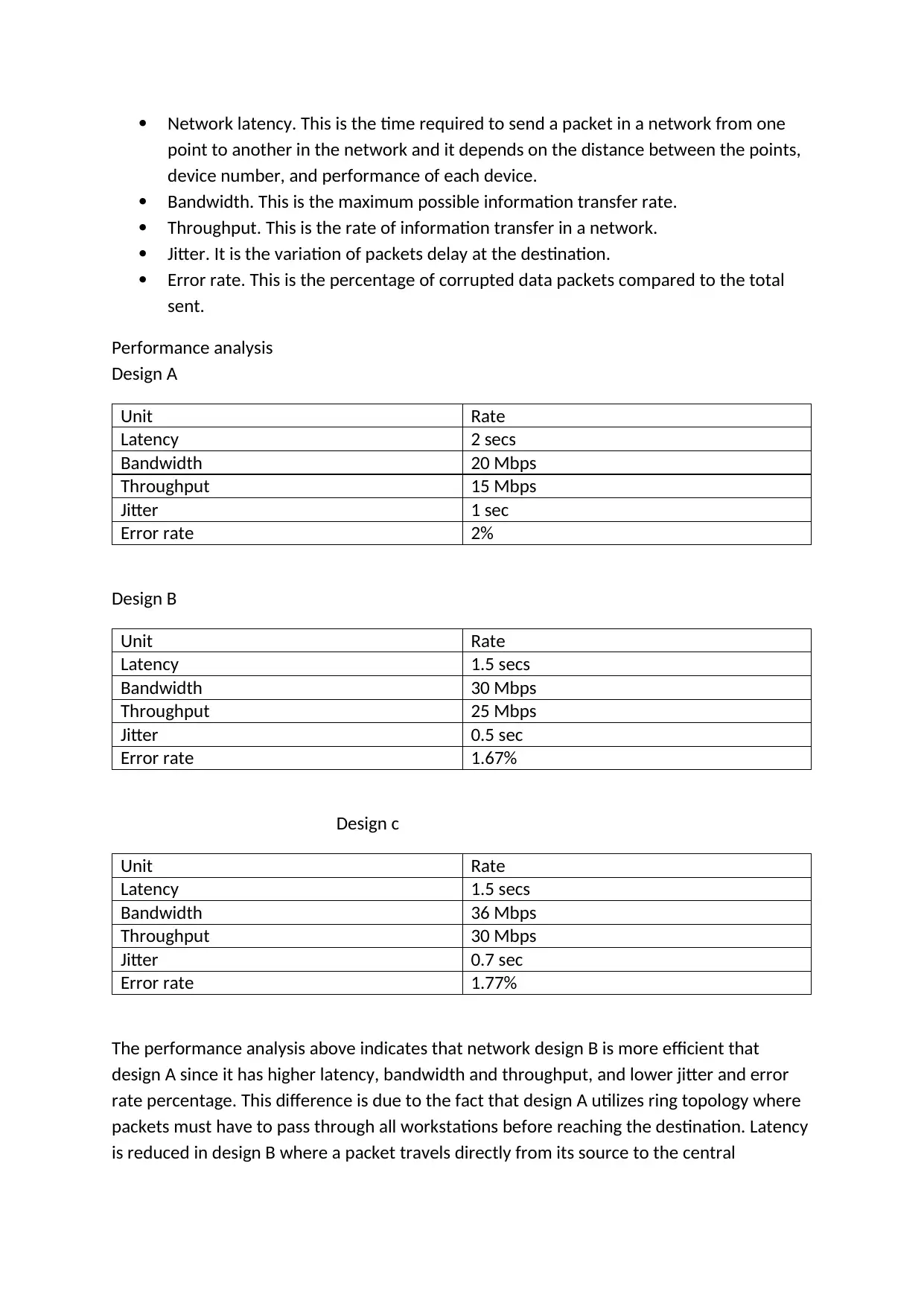
Network latency. This is the time required to send a packet in a network from one
point to another in the network and it depends on the distance between the points,
device number, and performance of each device.
Bandwidth. This is the maximum possible information transfer rate.
Throughput. This is the rate of information transfer in a network.
Jitter. It is the variation of packets delay at the destination.
Error rate. This is the percentage of corrupted data packets compared to the total
sent.
Performance analysis
Design A
Unit Rate
Latency 2 secs
Bandwidth 20 Mbps
Throughput 15 Mbps
Jitter 1 sec
Error rate 2%
Design B
Unit Rate
Latency 1.5 secs
Bandwidth 30 Mbps
Throughput 25 Mbps
Jitter 0.5 sec
Error rate 1.67%
Design c
Unit Rate
Latency 1.5 secs
Bandwidth 36 Mbps
Throughput 30 Mbps
Jitter 0.7 sec
Error rate 1.77%
The performance analysis above indicates that network design B is more efficient that
design A since it has higher latency, bandwidth and throughput, and lower jitter and error
rate percentage. This difference is due to the fact that design A utilizes ring topology where
packets must have to pass through all workstations before reaching the destination. Latency
is reduced in design B where a packet travels directly from its source to the central
point to another in the network and it depends on the distance between the points,
device number, and performance of each device.
Bandwidth. This is the maximum possible information transfer rate.
Throughput. This is the rate of information transfer in a network.
Jitter. It is the variation of packets delay at the destination.
Error rate. This is the percentage of corrupted data packets compared to the total
sent.
Performance analysis
Design A
Unit Rate
Latency 2 secs
Bandwidth 20 Mbps
Throughput 15 Mbps
Jitter 1 sec
Error rate 2%
Design B
Unit Rate
Latency 1.5 secs
Bandwidth 30 Mbps
Throughput 25 Mbps
Jitter 0.5 sec
Error rate 1.67%
Design c
Unit Rate
Latency 1.5 secs
Bandwidth 36 Mbps
Throughput 30 Mbps
Jitter 0.7 sec
Error rate 1.77%
The performance analysis above indicates that network design B is more efficient that
design A since it has higher latency, bandwidth and throughput, and lower jitter and error
rate percentage. This difference is due to the fact that design A utilizes ring topology where
packets must have to pass through all workstations before reaching the destination. Latency
is reduced in design B where a packet travels directly from its source to the central
Paraphrase This Document
Need a fresh take? Get an instant paraphrase of this document with our AI Paraphraser
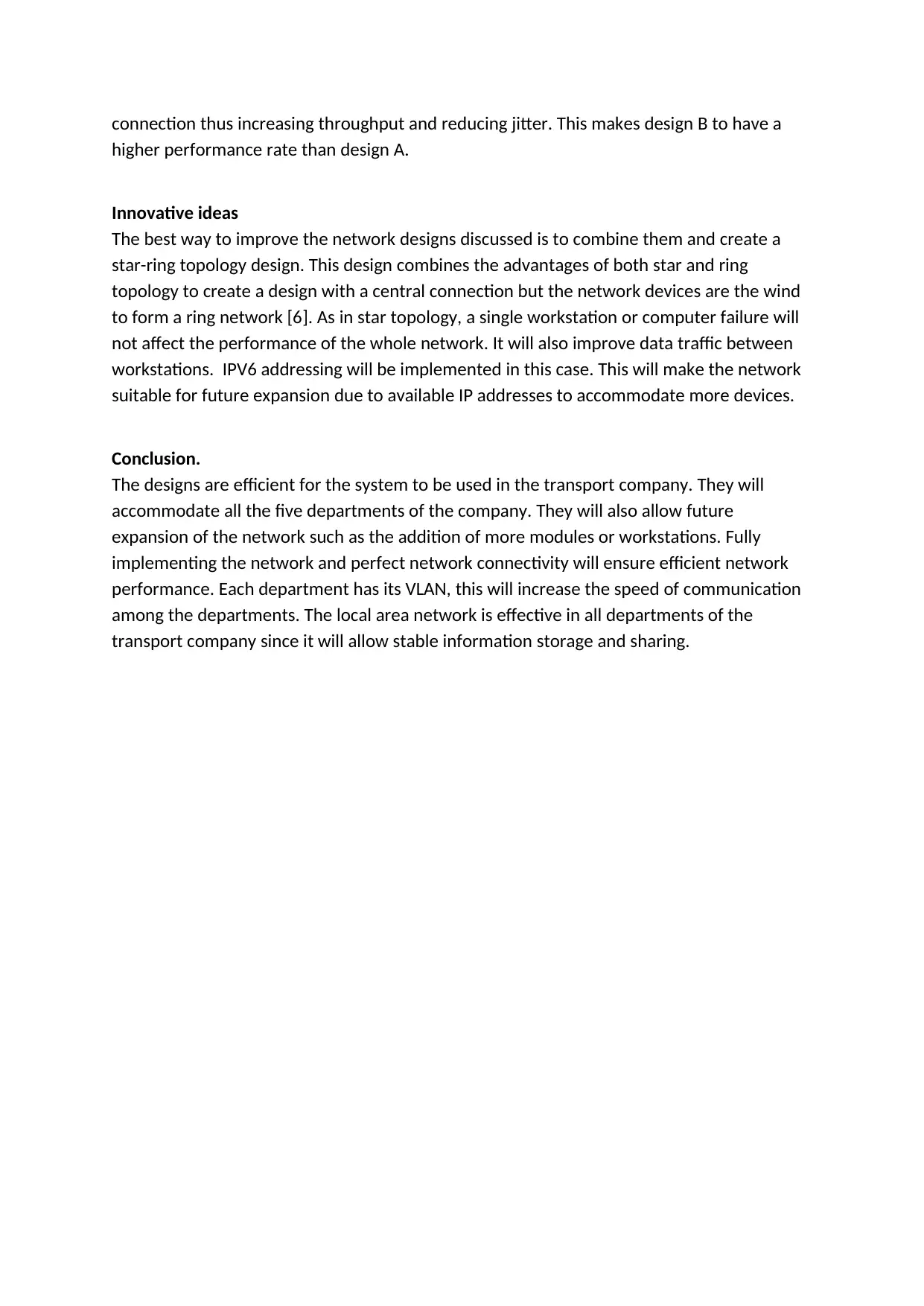
connection thus increasing throughput and reducing jitter. This makes design B to have a
higher performance rate than design A.
Innovative ideas
The best way to improve the network designs discussed is to combine them and create a
star-ring topology design. This design combines the advantages of both star and ring
topology to create a design with a central connection but the network devices are the wind
to form a ring network [6]. As in star topology, a single workstation or computer failure will
not affect the performance of the whole network. It will also improve data traffic between
workstations. IPV6 addressing will be implemented in this case. This will make the network
suitable for future expansion due to available IP addresses to accommodate more devices.
Conclusion.
The designs are efficient for the system to be used in the transport company. They will
accommodate all the five departments of the company. They will also allow future
expansion of the network such as the addition of more modules or workstations. Fully
implementing the network and perfect network connectivity will ensure efficient network
performance. Each department has its VLAN, this will increase the speed of communication
among the departments. The local area network is effective in all departments of the
transport company since it will allow stable information storage and sharing.
higher performance rate than design A.
Innovative ideas
The best way to improve the network designs discussed is to combine them and create a
star-ring topology design. This design combines the advantages of both star and ring
topology to create a design with a central connection but the network devices are the wind
to form a ring network [6]. As in star topology, a single workstation or computer failure will
not affect the performance of the whole network. It will also improve data traffic between
workstations. IPV6 addressing will be implemented in this case. This will make the network
suitable for future expansion due to available IP addresses to accommodate more devices.
Conclusion.
The designs are efficient for the system to be used in the transport company. They will
accommodate all the five departments of the company. They will also allow future
expansion of the network such as the addition of more modules or workstations. Fully
implementing the network and perfect network connectivity will ensure efficient network
performance. Each department has its VLAN, this will increase the speed of communication
among the departments. The local area network is effective in all departments of the
transport company since it will allow stable information storage and sharing.
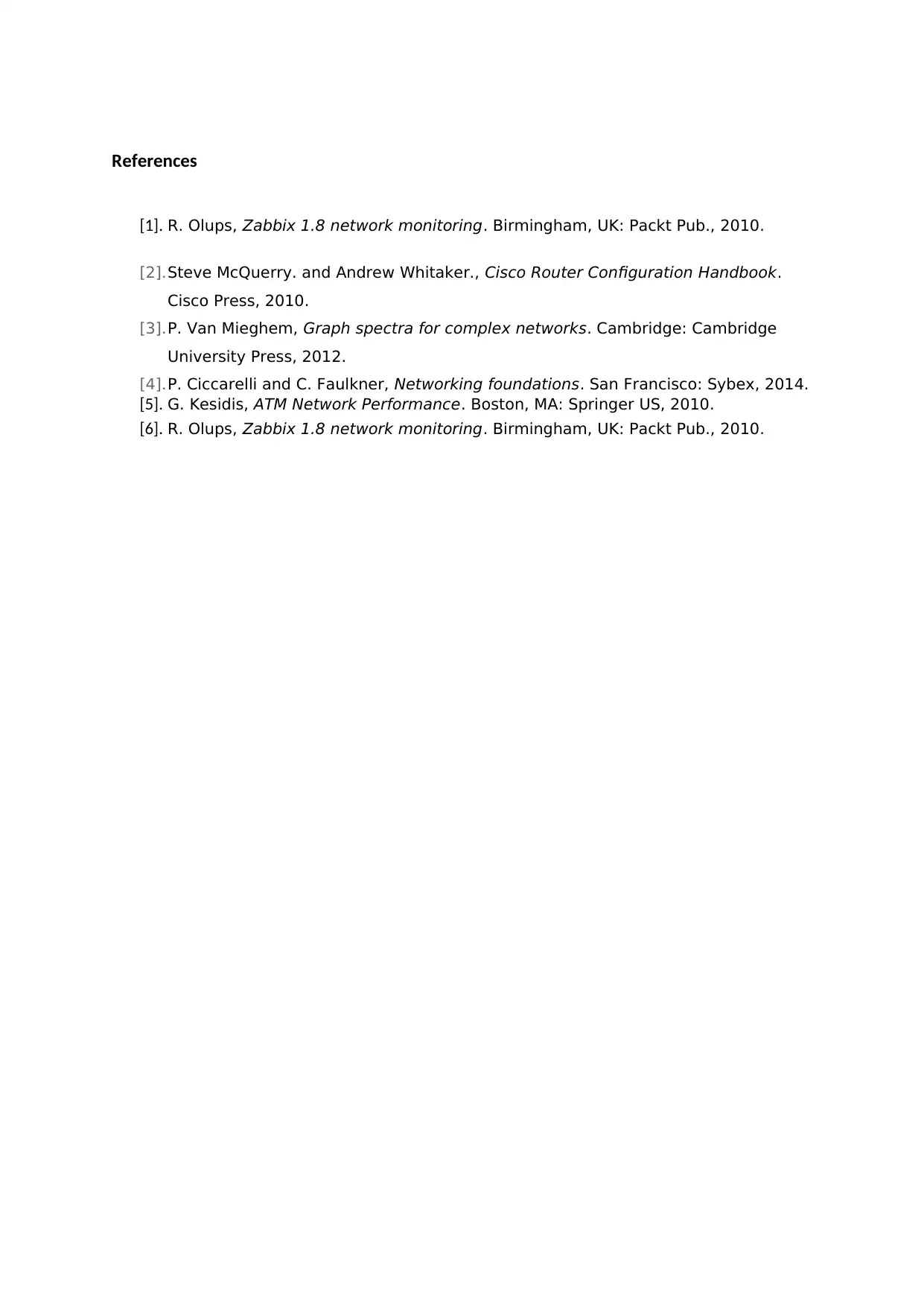
References
[1]. R. Olups, Zabbix 1.8 network monitoring. Birmingham, UK: Packt Pub., 2010.
[2].Steve McQuerry. and Andrew Whitaker., Cisco Router Configuration Handbook.
Cisco Press, 2010.
[3].P. Van Mieghem, Graph spectra for complex networks. Cambridge: Cambridge
University Press, 2012.
[4].P. Ciccarelli and C. Faulkner, Networking foundations. San Francisco: Sybex, 2014.
[5]. G. Kesidis, ATM Network Performance. Boston, MA: Springer US, 2010.
[6]. R. Olups, Zabbix 1.8 network monitoring. Birmingham, UK: Packt Pub., 2010.
[1]. R. Olups, Zabbix 1.8 network monitoring. Birmingham, UK: Packt Pub., 2010.
[2].Steve McQuerry. and Andrew Whitaker., Cisco Router Configuration Handbook.
Cisco Press, 2010.
[3].P. Van Mieghem, Graph spectra for complex networks. Cambridge: Cambridge
University Press, 2012.
[4].P. Ciccarelli and C. Faulkner, Networking foundations. San Francisco: Sybex, 2014.
[5]. G. Kesidis, ATM Network Performance. Boston, MA: Springer US, 2010.
[6]. R. Olups, Zabbix 1.8 network monitoring. Birmingham, UK: Packt Pub., 2010.
⊘ This is a preview!⊘
Do you want full access?
Subscribe today to unlock all pages.

Trusted by 1+ million students worldwide
1 out of 9
Related Documents
Your All-in-One AI-Powered Toolkit for Academic Success.
+13062052269
info@desklib.com
Available 24*7 on WhatsApp / Email
![[object Object]](/_next/static/media/star-bottom.7253800d.svg)
Unlock your academic potential
Copyright © 2020–2025 A2Z Services. All Rights Reserved. Developed and managed by ZUCOL.





